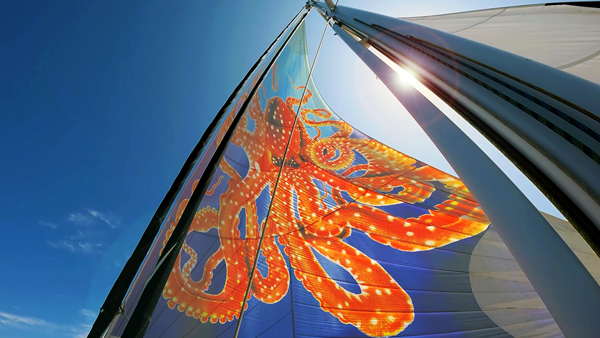Our Code Zero sail was built explicitly for light wind sailing, and as such, it falls within the family of genoas and asymmetrical spinnakers. On this passage, we were thrilled to watch it flying out in front of Esper.


As soon as we began the three-day sail across the Flores Sea, we hit the south-east trade winds. Dropping south from Benteng, and sailing parallel to Indonesia’s famous holiday islands, we could make out Flores and Komodo to the south. Somewhere in front of us, lost in the haze, lay Bali and Java.

Meet ‘The Kraken’: Our Code Zero Sail
Much of this passage was spent under sail with our Code Zero, which we’ve affectionately named “The Kraken” thanks to its massive octopus design. For those unfamiliar, a Code Zero is a sail designed specifically for light winds, similar to a genoa. On our boat, which is rigged with a high-cut Yankee that doesn’t perform well in lighter air, the Kraken is beneficial.
Our Code Zero Sail Setup
We hoist our Code Zero to the top of the main mast and run it on a furler, which we clip to the bow. This is particularly useful for us because Esper is rigged with a high-cut yankee and doesn’t perform well in light winds. The Kraken does.
How We Set Up Our Code Zero
The setup for the Kraken is streamlined for ease of use. Once hoisted, two key lines control it:
- A Continuous Furling Line: This single, continuous loop allows us to furl and unfurl the sail from the safety of the cockpit.
- A Single Sheet: The sheet is run back to the cockpit through a block. You might notice in our videos that the sheet is exceptionally long. There’s a practical reason for this! To furl the Code Zero away, you need to be able to hold onto the sheet to prevent the clew from flapping about. The extra length allows one person to go forward of the mast to manage the furling line while still being able to control the sheet.
This setup enables single-handed handling of the sail, a significant advantage when sailing as a couple.
How Much Wind Can It Handle?
This is a question we are frequently asked. When our rigger first installed it, his advice was that we could use it in “anything you feel comfortable with.” For us, we’ve found that a range of 12-15 knots is comfortable.
Interestingly, we posted this question to an online owners’ forum and received a reply from the skipper of an 85-foot Oyster who said he has had his Code Zero out in 30 knots of wind! Different sail manufacturers have different definitions of a Code Zero, so it’s always worth noting that capabilities can vary.


In episode 337 on our YouTube channel, we get into more detail of the setup and about how, when and why we use our code zero.
Stratovolcano looming out of the haze
As we headed east towards Lombok, we watched the tip of Mt Tambora appear on the horizon. It’s big, dominating the horizon, because it is a stratovolcano and they are the biggest in the world. This one is on the northern coast of Sumbawa island, but it isn’t any old volcano. In 1815 it caused the largest volcanic eruption in recorded history.

The eruption sent tsunamis across the Java and Flores Seas, where geologists and historians estimate that 10,000 people were annihilated. In 1816, the world fell into a gloomy winter which came to be known as “the year without a summer”.

Mt Tambora is still active today, and that gave us pause for thought as we came closer. After a couple of smaller eruptions (in 1880 and 1967) it has increased its seismic activity once more, exploding in 2011, 2012, and 2013…
Check out the full story in episode 337 on our YouTube channel:
https://youtu.be/CFRtGIt_CnA
If you like our content and would like to support us, we will give you ad-free access to our videos before they go live to the public, discounts in our shop, access to Jamie’s iconic full-res photographs, and supporter-only blog posts. Click our ugly mugs for more info!




Hey guys I love your channel because it is such a great mix between travel and sailing techniques. I was very interested in your Code 0 episode. In the video you mentioned that it is not a downwind sail but is more suited for sailing on a reach. In looking at the sail and setup, you seemed to only sail it on a port tack. If the tack of the Code 0 is clipped in to the bow sprit and you control it with one starboard side sheet, then how do you tack the boat? Can you? Do you clip the new tack and rig a new sheet (to the old tack) to bring the sail over to a starboard tack? Or do you bring the sheet and sail around and sail the Code 0 backwards? Thanks so much in advance — I am shopping for my own staysail ketch rig now and hope to be out there soon, and I obviously have no experience with a Code 0 setup. Mark from Marblehead MA
We manually move it round and sail it ‘backwards’. We only really use it for long sails when we don’t expect to tack. Cheers. Liz
Hi, Jamie and Liz. Your Discord link seems to have expired. Can you send/post a new one? Looking forward to joining the discussion.
Yves. .
Sorry about that, Yves. I did set it to ‘not expire’ but it didn’t save. Anyway, try this: https://discord.gg/H9jmztupTx